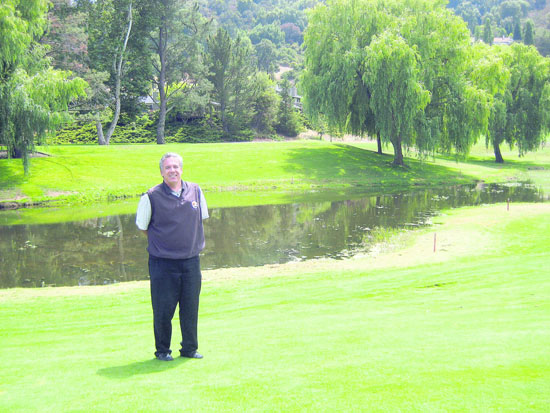|
|
Published August 20, 2008
|
Country Clubs Cope with Drought
|
| By Sophie Braccini |
 |
| Top: Moraga Country Club diving range Photos Andy Scheck |
Saving 19% on your water consumption is not an easy thing to do, but what if you had to save 30%? Whether they like it or not, that’s the target for the “irrigation” customers of the East Bay Municipal Utility District (EMBUD). There are no large fields in Lamorinda, no crops on the hills, but there are two country clubs with acres of green grass consuming thousands of gallons of water a year that must now cut their watering by 30% in the middle of summer. Will the “greens” soon be renamed the “yellows?”
The two clubs face very different challenges. The Orinda Country Club (OCC), with its Lake Cascade, collects enough from rain and runoff to water the golf course. The club has owned the lake since the ‘20s when it was created. EBMUD water is used for the club house, swimming pool, tennis, and fitness, which are commercial usage so subject to “only” a 9% reduction. OCC has taken steps to meet that requirement by providing patrons with water on request only, by making time adjustments for cleaning golf carts and asking players to take shorter showers.
Last autumn, OCC had to use EBMUD water for the grounds due to the weather conditions. “This year, we have adopted a conservative approach to our watering,” explains John Bether, the club’s Manager, “we have concerns for our lake that’s been stressed by two consecutive seasons.” As a consequence, some of the grounds are being allowed go brown. Bether doesn’t believe that the fairways and greens will be impacted, mostly the rough.
In Moraga, the ponds are used for a small part of the irrigation but most of the water comes from EBMUD. For Frank Melòn, General Manager of the Moraga Country Club (MCC), the challenge is quite significant. “We have been proactive and have worked with EBMUD on water efficiency for years,” explains Melòn, “over the past 10 years, our consumption decreased by 38.9%.” This was achieved with, for example, the installation of a weather station that reads the evaporation rate of the grass and determines the amount a watering needed (testing the evapotranspiration). As a result, the club will be applying for an exemption.
“Any irrigation customer who applies for an exemption needs to prove that they are already an efficient irrigator,” explains Dave Langridge. Langridge is EBMUD’s conservation specialist, who works with MCC and any large user who wishes to optimize their water usage techniques.
Even if the 30% objective is high, Melòn plans to try to reach it this year. For the future, he has even more ambitious plans, drawing on his experience in hotter climates than Lamorinda. He worked at golf courses in Southern California and in the Palm Springs desert for thirty years. These more drastic water conditions gave him exposure to such techniques as tertiary treatment of wastewater. “This is a technique that’s been used for many years now and produces a water of superior quality,” explains the General Manager, who is working with EBMUD and the Sanitary District on a tertiary water treatment plant for the Club. “We want to do the right thing for the community and the Bay Area,” explains Melòn.
At this time, the project is in its feasibility study phase. Linda Hu, Supervisor of the Office of Water Recycling for EBMUD, is very interested in the possibility. She explains that other golf courses such as Gale Ranch in San Ramon use recycled water for their lawns. Their water comes from a nearby recycled water facility. There is no such thing for Moraga and the Country Club will have to build its own facility; the study will determine, among other aspects, if this is financially viable. |
 |
| Frank Melòn by one of the Club’s ponds Photo Sophie Braccini |
|
|
|
|
|
| Reach Sophie Braccini at: sophie@lamorindaweekly.com |
|
|


